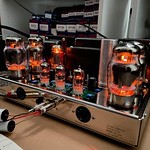 by audioregenesis Tue Aug 21, 2018 1:28 pm
by audioregenesis Tue Aug 21, 2018 1:28 pm
Understanding the loading requirements is one of the most important, yet least understood, aspects of using a PAS 2/3 with more contemporary power amplifiers. Thus, it has been extensively covered in the Audioregenesis line stage and compatibilty articles. Being engineering papers, of necessity they are somewhat technical, so not everyone will be able to comprehend, but the information is there for those who can. The compatibility article is perhaps more understandable for the less techically inclined.
Basically, for flat bass response with the tone controls centered, the PAS 2/3 (not 3X) must see a 50K impedance at the output. It's a design requirement because of the way the tone controls were implemented, and the source of much confusion since it's not generally understood what the load consists of. Part of that 50K load is inside the PAS itself, while the other part is the power amplifier it is driving. The parallel combination of PAS internal load resistors and the power amplifier input impedance is the total load, which must be 50K, or close to that. When used with tube power amplifiers, as originally intended, the internal load resistors (68K and 510K in parallel) primarily determine the load since the 500K (typ) input impedance of the PA is so high. So, the total load is close to the required 50K for most cases when tube PA's are used. However, when lower impedance PA's are connected, their input impedance drags down the total load impedance to the point where the bass response is reduced, the extent depending upon the actual PA impedance. Within limits, the internal load resistors in the PAS may be increased so that the total load presented is close to 50K again preserving the bass response. The lowest permissible PA impedance would be 50K at which point the internal resistors in the PAS would be deleted entirely. Lower PA impedances than that can only be accomodated by bypassing the tone controls, or employing an external buffer stage. The 3X, of course, does bypass the tone controls at center.
Note that the case given for a 100K internal load is valid ONLY for the condition where the power amplifier input impedance is 100K. Thus, 100K internal load in parallel with 100K PA load once again restores the total load to the 50K requirement. A 100K internal load used with a high impedance tube amp would result in increased bass response. So called TUNING the PAS is simply the act of altering the internal load resistors to restore the required 50K total load impedance with a specific power amplifier, within the limits it allows. If the PA impedance is 50K or more, it will be within the limits that altering the internal PAS load resistors will allow.
Last edited by audioregenesis on Tue Aug 21, 2018 3:45 pm; edited 2 times in total (Reason for editing : Correcting typos - using a mobile device so lots of typing a bit of a pain)




